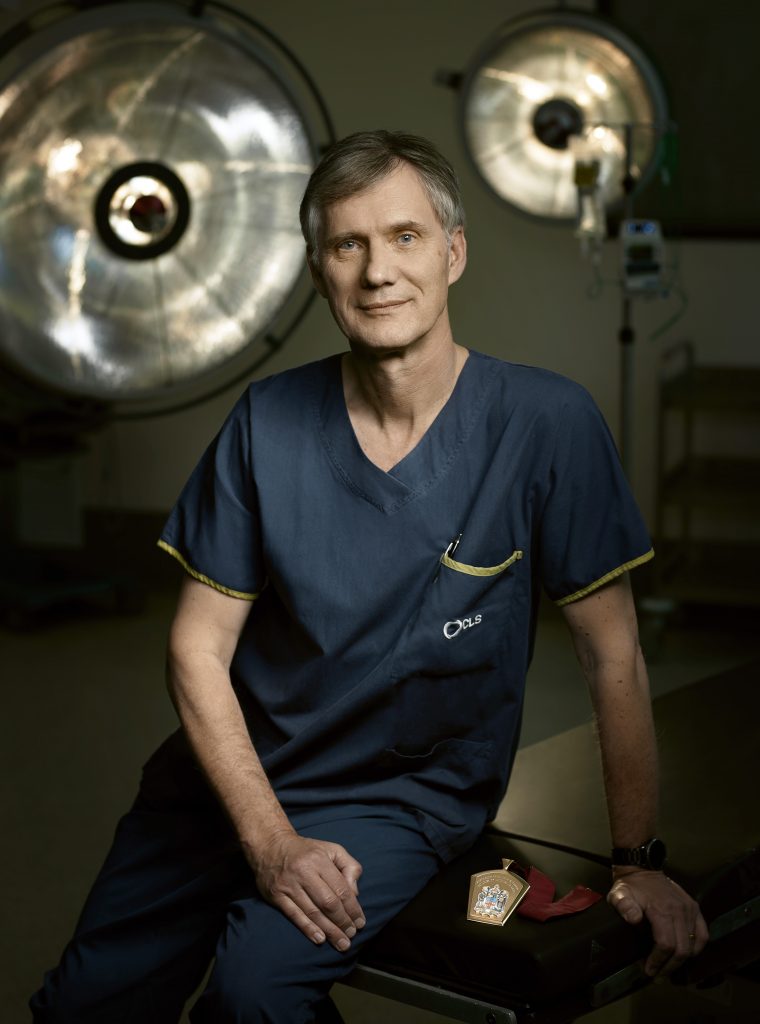At the end of each president’s term, the Australian and New Zealand College of Anaesthetists (ANZCA) commissions a portrait. There is now quite the collection of painted portraits dating back to 1992, when the college formally came into being. In 2016, ANZCA Council decided to work with photography as a medium for these portraits, and outgoing president, Dr Genevieve Goulding, worked with photographic portrait artist, Chris Budgeon, to create her portrait. In 2018, the immediate past president, Professor David A Scott also chose to work with Chris, producing a very different portrait, which is now hanging in the Council Room. Professor Scott has prepared some reflections about the process and the outcome.

Artist: Chris Budgeon
Location: St. Vincent’s Hospital Melbourne, Fitzroy. Operating Suite (OR 8)
Date taken: 17 September 2018
Location in an operating room because that is where the majority of my professional career has been spent in providing clinical anaesthesia, as is true for most specialist anaesthetists. The venue was chosen after consideration of a number of options including the President’s office, Council room and the garden in front of ANZCA. The theatre (and lights) were commissioned in 1995 (only 3 years after the College was independently established from RACS) and so rather than represent a newer ‘cutting edge’ environment, it is more contemporary to my latter career and practice.
Wearing theatre scrubs, because again that is what we (as anaesthesiologists) most commonly are wearing during day-to-day work, and many patients identify with this. Clearly it is relative, but it is valuable to emphasise. The logo, “CLS” represents a linen service delivered by a private hospital group (Cabrini). This could be suggested to be linking public and private health care.
The President’s Medal is essential and represents my role with the College and its Faculty of Pain Medicine, and the binational representation of the organisation. It is not around my neck because the link to the College for most fellows during clinical work is ‘side by side’ rather than surrounding. It would also be at odds visually with the clinical role in scrubs to have it round my neck.
The Infusion pump in the background is symbolic and represents three things. It is set up as a local anaesthetic infusion for an epidural or perineural catheter infusion for intra-operative use and post-operative analgesia. First is that it represents my long-term interest in regional anaesthesia in both clinical practise and research. Second, and importantly, is that it represents Acute Pain Medicine which I have been involved with for over 30 years and is my link to my Fellowship of the Faculty of Pain Medicine. Finally, its role in postoperative care is an acknowledgement of future, more formalised, perioperative medicine roles of anaesthesia and pain medicine.
The pen in my pocket represents communication. Documentation and communication is essential to medical practice and effective and safe patient care. Although electronic medical records are phasing in, almost all my practice has been with pen and paper record keeping. As a deliberate inclusion, the pen is from the Australian Society of Anaesthetists, and thus also represents my, and the College’s, important and close relationships with the Australian and New Zealand Societies.
My watch is electronic and connected by Bluetooth to my phone and the world. This represents my perspective for the future, in communication, connectivity and patient care and monitoring.
The process of commissioning and creating the portrait. This is only the second photographic portrait that the college has commissioned after Council decided to discontinue painted portraits of past presidents. In consultation with Monica Cronin, whose views I respect and value, and who is Curator of the ANZCA Geoffrey Kaye Museum of Anaesthetic History, I decided to work with Chris Budgeon, who had done the portrait of the previous president (Genevieve Goulding). Chris seemed to have an eye for the individual in their environment, which I liked, and also he used the ‘darker’ tones (optically, not sinister) in his work which tended to support my view of how the background could be represented. His assistants, Sam Costin and Eve von Bibra were great (although Eve made my hair too neat!). Chris was a pleasure to work with and generous in incorporating my (few) suggestions. For my gaze, he asked me to think of something that was important to me. The outcome is for others to judge, but I am very content with the process, support, and how it seems to have worked out.
Professor David A Scott
